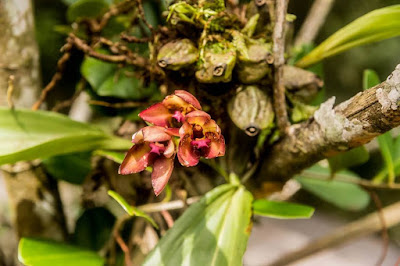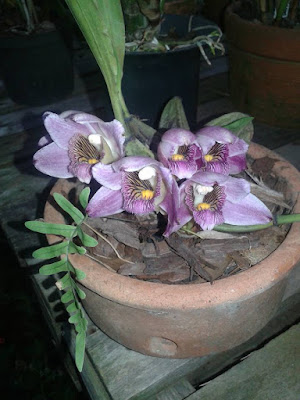Bifrenaria atropurpurea is found in Brazil, where it grows epiphytic on trees or lithophyte on rocks in mountainous, wet tropical forests at an altitude of 200 to 2000 meters above sea level...
Bifrenaria atropurpurea also called as The Black-Purple Bifrenaria, Bifrenaria atropurpurea var caparaoensis, Bifrenaria caparaoensis, Maxillaria atropurpurea, is a species of the genus Bifrenaria. This species was described by John Lindley in 1832.
IDENTIFY BIFRENARIA ATROPURPUREA ORCHID PLANT
Bifrenaria atropurpurea is found in Brazil, where it grows epiphytic on trees or lithophyte on rocks in mountainous, wet tropical forests at an altitude of 200 to 2000 meters above sea level.
It is a medium sized, warm to cool growing epiphytic or lithophytic species with egg shaped, 4 angled, up to 6 cm long pseudobulbs and a solitary, to 25 cm long, apical, broad-elliptic, acuminate, erect, glabrous, coriaceous leaf that has 3 prominent veins beneath.
The Black-Purple Bifrenaria blooms through the spring and summer in Brazil on a 7.5 cm long, basal, racemose, semi-erect inflorescence arising on a newly matured pseudobulb with 3 to 5, fleshy, fragrant flowers. The flowers are dark purple, they look upward, about 5 cm in diameter, similar in shape to bells. Sepals 3 cm long and 1.5 cm wide, lateral form a spur. The color of the warmer is closer to the base and turns into yellow color. The lip is pink, its lateral parts are straight, and the anterior margin is wavy, about 2.5 cm long.
BIFRENARIA ATROPURPUREA ORCHID PLANT CARE AND CULTURE
Cultural information should only be used as a guide, and should be to be adapted to suit you. Your physical location; where you grow your plants, how much time you have to devote to their care, and many other factors, will need to be taken into account. Only then can you decide on the cultural methods that best suit you and your plants.
Light:
Bifrenaria atropurpurea loves the bright sun without access to direct sunlight, so during the hot midday sun on the windows of the southern orientation and the hot evening sun on the western windows, the orchid should be placed behind a curtain (for example, on a table near the window) or in the shade of other plants. Otherwise, the orchid can get sunburn.
Temperature:
This type of orchid belongs to a moderately warm temperature regime, and during the whole year it is recommended to keep the plants under the following temperature conditions: Summer temperature is up to 32 ° C in the daytime and 18-20 ° C at night; Winter temperature at 14-18 ° C. For the successful cultivation at home, it is necessary that the night temperature of the content is always at 4 ° C (ideally 10 ° C) lower than the daytime temperature.
Humidity:
The Black-Purple Bifrenaria needs relatively high humidity, not less than 60%, ideally 70-80%. Too dry air adversely affects the development of the plant: its growth is inhibited, and the leaves begin to turn yellow and dry.
Substrate, growing media and repotting:
Bifrenaria atropurpurea can grow in pots or hanging lattice baskets and placed on blocks. As a substrate, the mixture of the bark of coniferous trees and moss sphagnum is best. When growing orchids on blocks to prevent rapid drying of the root system of the plant, it is recommended to make a small interlayer of moss between it and the block. Above the roots, you can also put live or dry sphagnum.
Repotting is desirable only in cases of severe compaction or salinization of the substrate, its critically low or high pH or when the plant grows very much and the old pot will become too small for him. The best time to transplant is considered to be a period when new shoots reach a size of 5 cm and begin to build up their own roots.
Watering:
During the period of new growth, this species needs frequent and abundant watering. Plants growing on blocks should be watered daily in the morning, so that by evening the roots of the orchids could dry out relatively well. When watering orchids in pots, it is necessary to remember that excess water during watering should flow freely out of the pot, as the stagnation of water both inside the pot and in its pallet can very quickly lead to rotting of the roots and the lower part of the plant. The substrate between the irrigations should dry relatively well, but do not dry completely.
Fertilizer:
During the new growth period, this type of orchids is fertilized every 2 weeks in the usual fertilizer concentration indicated on the package. In addition to the usual root top dressing, it is also recommended to produce a foliar dressing, when a very much diluted fertilizer is sprayed on the outer part of the plant. It is best to feed the orchid, alternating both these methods.
Rest period:
To stimulate flowering, Bifrenaria atropurpurea needs a clearly defined period of rest. It begins immediately after the formation of new pseudobulbs, i.e., when new, young shoots reach the size of old ones and begin to turn into pseudobulbs (rounded), and is expressed in the fact that the orchid is kept somewhat drier and colder than usual, and not fertilize. The total temperature of the content should be 18-20 ° C in the daytime and about 14-16 ° C at night. Watering the orchids needs to be coordinated at relatively lower temperatures and produce little by little, so that the substrate between waterings does not just dry out well, but it is completely dry for at least a week. With the advent of peduncles, the rest period ends: the total temperature of the content increases, and watering resumes in the usual volume.















COMMENTS